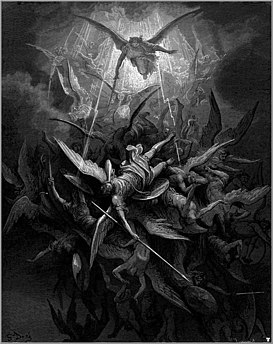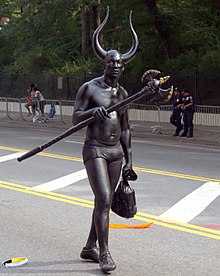
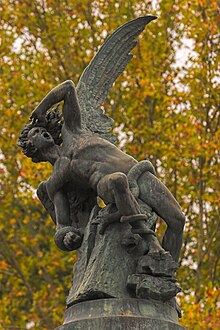
Fallen angels are angels who were expelled from Heaven. The literal term "fallen angel" does not appear in any Abrahamic religious texts, but is used to describe angels cast out of heaven or angels who sinned. Such angels often tempt humans to sin.
The idea of fallen angels is derived from the Book of Enoch, a Jewish pseudepigraphic apocalyptic religious text, or the assumption that the "sons of God" (בני האלוהים) mentioned in Genesis 6:1–4 are angels. In the period immediately preceding the composition of the New Testament, some sects of Second Temple Judaism identified these same "sons of God" as fallen angels. During the late Second Temple period the Nephilim were considered the monstrous offspring of fallen angels and human women. In such accounts, God sends the Great Deluge to purge the world of these creatures; their bodies are destroyed, yet their peculiar souls survive, thereafter roaming the earth as demons. Rabbinic Judaism and early Christian authorities after the third century rejected the Enochian writings and the notion of an illicit union between angels and women producing hybrids. Christian theology indicates the sins of fallen angels occur before the beginning of human history. Accordingly, fallen angels became identified with those led by Lucifer in rebellion against God, also equated with demons.
In Islam, belief in fallen angels is disputed. In early Quranic exegesis (tafsīr) there are two distinct opinions in regards of the obedience of angels, often revolving around the nature of Iblīs (Satan in Islam). According to the viewpoint of Ibn Abbas (619–687), Iblis was an angel created from fire (nār as-samūm), while according to Hasan of Basra (642–728), he was the progenitor of the jinn. Hasan al-Basri argued that angels are unable to sin. To eliminate the possibilities for fallen angels, he further interpretates Harut and Marut, mentioned in 2:102, as malikayn (kings) instead of malā'ikah (angels). Ibn Abbas, on the other hand, asserts that the verse in Surah 18:50 "except Iblis, he was one of the jinn", means "he was one of the inhabitants of paradise" and generally allows the concept of fallen angels within Islamic tradition.
Historians have discussed the relationship between Quranic jinn and fallen angels in Christian theology. Some of the primary issues for such a relationship is that the former are not identified as "angels" and that, unlike angels, they are described as ascending to the sky where they eavesdrop on heavenly secrets. In classical Islamic traditions, the jinn are often thought of as a race of Pre-Adamites, who dwelt on Earth.
Second Temple period
The concept of fallen angels derives mostly from works dated to the Second Temple period between 530 BC and 70 AD: in the Book of Enoch, the Book of Jubilees, and the Qumran Book of Giants; and perhaps in Genesis 6:1–4. A reference to heavenly beings called "Watchers" originates in Daniel 4, in which there are three mentions, twice in the singular (v. 13, 23), once in the plural (v. 17), of "watchers, holy ones". The Ancient Greek word for watchers is ἐγρήγοροι (egrḗgoroi, plural of egrḗgoros), literally translated as "wakeful". Some scholars consider it most likely that the Jewish tradition of fallen angels predates, even in written form, the composition of Gen 6:1–4. In the Book of Enoch, these Watchers "fell" after they became "enamored" with human women. The Second Book of Enoch (Slavonic Enoch) refers to the same beings of the (First) Book of Enoch, now called Grigori in the Greek transcription. Compared to the other Books of Enoch, fallen angels play a less significant role in 3 Enoch. 3 Enoch mentions only three fallen angels called Azazel, Azza and Uzza. Similar to The first Book of Enoch, they taught sorcery on earth, causing corruption. Unlike the first Book of Enoch, there is no mention of the reason for their fall and, according to 3 Enoch 4.6, they also later appear in heaven objecting to the presence of Enoch.
1 Enoch

According to 1 Enoch 7.2, the Watchers become "enamoured" with human women and have intercourse with them. The offspring of these unions, and the knowledge they were giving, corrupt human beings and the earth (1 Enoch 10.11–12). Eminent among these angels are Samyaza and Azazel. Like many other fallen angels mentioned in 1 Enoch 8.1–9, Azazel introduces men to "forbidden arts", and it is Azazel who is rebuked by Enoch himself for illicit instruction, as stated in 1 Enoch 13.1. According to 1 Enoch 10.6, God sends the archangel Raphael to chain Azazel in the desert Dudael as punishment. Further, Azazel is blamed for the corruption of earth:
1 Enoch 10:12: "All the earth has been corrupted by the effects of the teaching of Azazyel. To him therefore ascribe the whole crime."
An etiological interpretation of 1 Enoch deals with the origin of evil. By shifting the origin of mankind's sin and their misdeeds to illicit angel instruction, evil is attributed to something supernatural from without. This motif, in 1 Enoch, differs from that of later Jewish and Christian theology; in the latter evil is something from within. According to a paradigmatic interpretation, 1 Enoch might deal with illicit marriages between priests and women. As evident from Leviticus 21:1–15, priests were prohibited to marry impure women. Accordingly, the fallen angels in 1 Enoch are the priests counterpart, who defile themselves by marriage. Just like the angels are expelled from heaven, the priests are excluded from their service at the altar. Unlike most other apocalyptic writings, 1 Enoch reflects a growing dissatisfaction with the priestly establishments in Jerusalem in the 3rd century BC. The paradigmatic interpretation parallels the Adamic myth in regard of the origin of evil: In both cases, transcending one's own limitations inherent in their own nature causes their fall. This contrasts the etiological interpretation, which implies another power besides God, in heaven. The latter solution therefore poorly fits into monotheistic thought. Otherwise, the introduction to illicit knowledge might reflect a rejection of foreign Hellenistic culture. Accordingly, the fallen angels represent creatures of Greek mythology, which introduced forbidden arts, used by Hellenistic kings and generals, resulting in oppression of Jews.
2 Enoch
The concept of fallen angels is also in the Second Book of Enoch. It tells about Enoch's ascent through the layers of heaven. During his journey, he encounters fallen angels imprisoned in the 2nd heaven. At first, he decides to pray for them, but refuses to do so, since he himself as merely human, would not be worthy to pray for angels. In the 5th heaven however, he meets other rebellious angels, here called Grigori, remaining in grief, not joining the heavenly hosts in song. Enoch tries to cheer them up by telling about his prayers for their fellow angels and thereupon they join the heavenly liturgy.
Strikingly, the text refers to the leader of the Grigori as Satanail and not as Azael or Shemyaza, as in the other Books of Enoch. But the Grigori are identified with the Watchers of 1 Enoch.
The narration of the Grigori in 2 Enoch 18:1–7, who went down on to earth, married women and "befouled the earth with their deeds", resulting in their confinement under the earth, shows that the author of 2 Enoch knew about the stories in 1 Enoch. The longer recension of 2 Enoch, chapter 29 refers to angels who were "thrown out from the height" when their leader tried to become equal in rank with the Lord's power (2 Enoch 29:1–4), an idea probably taken from Ancient Canaanite religion about Attar, trying to rule the throne of Baal.
Jubilees
The Book of Jubilees, an ancient Jewish religious work, accepted as canonical by the Ethiopian Orthodox Church and Beta Israel, refers to the Watchers, who are among the angels created on the first day. However, unlike the (first) Book of Enoch, the Watchers are commanded by God to descend to earth and to instruct humanity. It is only after they copulate with human women that they transgress the laws of God. These illicit unions result in demonic offspring, who battle each other until they die, while the Watchers are bound in the depths of the earth as punishment. In Jubilees 10:1, another angel called Mastema appears as the leader of the evil spirits. He asks God to spare some of the demons, so he might use their aid to lead humankind into sin. Afterwards, he becomes their leader:
Lord, Creator, let some of them remain before me, and let them harken to my voice, and do all that I shall say unto them; for if some of them are not left to me, I shall not be able to execute the power of my will on the sons of men; for these are for corruption and leading astray before my judgment, for great is the wickedness of the sons of men. (10:8)
Both the (first) Book of Enoch and the Book of Jubilees include the motif of angels introducing evil to humans. However, unlike the Book of Enoch, the Book of Jubilees does not hold that evil was caused by the fall of angels in the first place, although their introduction to sin is affirmed. Further, while the fallen angels in the Book of Enoch are acting against God's will, the fallen angels and demons in the Book of Jubilees seem to have no power independent from God but only act within his power.
Rabbinic Judaism
Early Rabbinic literature
Although the concept of fallen angels developed from Jewish texts written during the Second Temple period, rabbis from the second century onward turned against the Enochian writings, probably in order to prevent fellow Jews from worship and veneration of angels. Thus, while many angels were individualized and sometimes venerated during the Second Temple period, the status of angels was degraded to a class of creatures on the same level of humans, thereby emphasizing the omnipresence of God. The 2nd-century rabbi Shimon bar Yochai cursed everyone who explained the term "sons of God" as angels. He stated sons of God were actually sons of judges or sons of nobles. Evil was no longer attributed to heavenly forces, now it was dealt as an "evil inclination" (yetzer hara) within humans. In some Midrashic works, the "evil inclination" is attributed to Samael, who is in charge of several satans in order to test humanity. Nevertheless, these angels are still subordinate to God; the reacceptance of rebel angels in Midrashic discourse was posterior and probably influenced by the role of fallen angels in Islamic and Christian lore.
Post-Talmudic works
The idea of rebel angels in Judaism reappears in the Aggadic-Midrashic work Pirke De-Rabbi Eliezer, which shows not one, but two falls of angels. The first one is attributed to Samael, who refuses to worship Adam and objects to God favoring Adam over the angels, ultimately descending onto Adam and Eve to tempt them into sin. This seems rooted in the motif of the fall of Iblis in the Quran and the fall of Satan in the Cave of Treasures. The second fall echoes the Enochian narratives. Again, the "sons of God" mentioned in Gen 6:1–4 are depicted as angels. During their fall, their "strength and stature became like the sons of man" and again, they give existence to the giants by intercourse with human women.
Kabbalah
Although not strictly speaking fallen, evil angels reappear in Kabbalah. Some of them are named after angels taken from the Enochian writings, such as Samael. According to the Zohar, just as angels can be created by virtue, evil angels are an incarnation of human vices, which derive from the qlippoth, the representation of impure forces.
However, the Zohar also recalls a narration of two angels in a fallen state, called Aza and Azael. These angels are cast down from the heaven after mistrusting Adam for his inclination towards sin. Once on Earth, they complete the Enochian narrative by teaching magic to humans and producing offspring with them, as well as consorting with Lilith (hailed as "the sinner"). In the narrative, the Zohar affirms but simultaneously prohibits magical practices. As a punishment, God puts the angels in chains, but they still copulate with the demoness Naamah, who gives birth to demons, evil spirits and witches.
Christianity
-
The Fall of the Rebel Angels (Apocryphal) (c. 1250), by William de Brailes. God sits on a throne within a mandorla. The rebelling angels are depicted as falling out of heaven and into a hell, in the shape of a mouth. As they fall, the angels become demons.
-
-
Angels fighting against fallen angels during the War in Heaven. Illustration by Gustave Doré for John Milton's Paradise Lost (1866)
Bible
Luke 10:18 refers to "Satan falling from heaven" and Matthew 25:41 mentions "the Devil and his angels", who will be thrown into Hell. All Synoptic Gospels identify Satan as the leader of demons. Paul the Apostle (c. 5 – c. 64 or 67) states in 1 Corinthians 6:3 that there are angels who will be judged, implying the existence of wicked angels. 2 Peter 2:4 and Jude 1:6 refer paraenetically to angels who have sinned against God and await punishment on Judgement Day. The Book of Revelation, chapter 12, speaks of Satan as the "Great Red Dragon" whose "tail swept a third part of the stars of heaven and cast them to the earth". In verses 7–9, Satan is defeated in the War in Heaven against Michael and his angels: "the great dragon was thrown down, that ancient serpent who is called the Devil and Satan, the deceiver of the whole world—he was thrown down to the earth and his angels were thrown down with him". Nowhere within the New Testament are fallen angels identified with demons, but by combining the references to Satan, demons, and angels, early Christian exegetes equated fallen angels with demons, for which Satan was regarded as the leader.
The First Epistle to the Corinthians in 11:10, according to the early Church Father Tertullian, references fallen angels; Tertullian taught that protection from the lust of the fallen angels was the reason for the Apostle Paul's directive to Christian women to wear a headcovering (veil). Tertullian referenced a woman who was touched on the neck by a fallen angel "who found her to be a temptation".
Origen and other early Christian writers linked the fallen morning star of Isaiah 14:12 of the Old Testament to Jesus' statement in Luke 10:18 that he "saw Satan fall like lightning from heaven", as well as a passage about the fall of Satan in Revelation 12:8–9. The Latin word lucifer, as introduced in the late 4th-century AD Vulgate, gave rise to the name for a fallen angel.
Christian tradition has associated Satan not only with the image of the fallen "morning star" in Isaiah 14:12, but also with the denouncing in Ezekiel 28:11–19 of the King of Tyre, who is spoken of as having been a "cherub". The Church Fathers saw these two passages as in some ways parallel, an interpretation also testified in apocryphal and pseudepigraphic works. However, "no modern evangelical commentary on Isaiah or Ezekiel sees Isaiah 14 or Ezekiel 28 as providing information about the fall of Satan".
Early Christianity
During the period immediately before the rise of Christianity, the intercourse between the Watchers and human women was often seen as the first fall of the angels. Christianity stuck to the Enochian writings at least until the third century. Many Church Fathers such as Irenaeus, Justin Martyr, Clement of Alexandria, and Lactantius accepted the association of the angelic descent to the sons of God passage in Genesis 6:1–4. However, some Christian ascetics, such as Origen (c. 184 – c. 253), rejected this interpretation. According to the Church Fathers who rejected the doctrine by Origen, these angels were guilty of having transgressed the limits of their nature and of desiring to leave their heavenly abode to experience sensual experiences. Irenaeus referred to fallen angels as apostates, who will be punished by an everlasting fire. Justin Martyr (c. 100 – c. 165) identified pagan deities as fallen angels or their demonic offspring in disguise. Justin also held them responsible for Christian persecution during the first centuries. Tertullian and Origen also referred to fallen angels as teachers of astrology.
The Babylonian king, who is described as a fallen "morning star" in Isaiah 14:1–17, was probably the first time identified with a fallen angel by Origen. This description was interpreted typologically both as an angel and a human king. The image of the fallen morning star or angel was thereby applied to Satan by early Christian writers, following the equation of Lucifer to Satan in the pre-Christian century.
Roman Catholicism
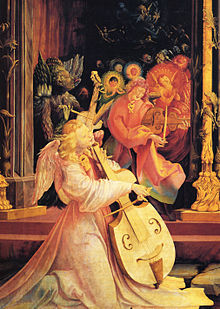

The subject of fallen angels is covered in a number of catechisms of the Roman Catholic Church, including Rev. George Hay's in which he answers the question What was the sin by which they fell?: "It was pride, arising from the great beauty and sublime graces which God had bestowed upon them. For, seeing themselves such glorious beings, they fell in love with themselves, and, forgetting the God that made them, wished to be on an equality with their Creator." The consequence of this fall being that, "they were immediately deprived of all their supernatural graces and heavenly beauty: they were changed from glorious angels into hideous devils; they were banished out of heaven, and condemned to the torments of hell, which was prepared to receive them."
In terms of the history of fallen angel theology it is thought to be rooted in Enochian literature, which Christians began to reject by the 3rd century. The sons of God came to be identified merely with righteous men, more precisely with descendants of Seth who had been seduced by women descended from Cain. The cause of evil was shifted from the superior powers of angels, to humans themselves, and to the very beginning of history; the expulsion of Satan and his angels on the one hand and the original sin of humans on the other hand. However, the Book of Watchers, which identified the sons of God with fallen angels, was not rejected by Syriac Christians or the Ethiopian Orthodox Tewahedo Church. Augustine of Hippo's work Civitas Dei (5th century) became the major opinion of Western demonology and for the Catholic Church. He rejected the Enochian writings and stated that the sole origin of fallen angels was the rebellion of Satan. As a result, fallen angels came to be equated with demons and depicted as non-sexual spiritual entities. The exact nature of their spiritual bodies became another topic of dispute during the Middle Ages. Augustine based his descriptions of demons on his perception of the Greek daimon. The Daimon was thought to be a spiritual being, composed of ethereal matter, a notion also used for fallen angels by Augustine. However, these angels received their ethereal body only after their fall. Later scholars tried to explain the details of their spiritual nature, asserting that the ethereal body is a mixture of fire and air, but that they are still composed of material elements. Others denied any physical relation to material elements, depicting the fallen angels as purely spiritual entities. But even those who believed the fallen angels had ethereal bodies did not believe that they could produce any offspring.
Augustine, in his Civitas Dei describes two cities (Civitates) distinct from each other and opposed to each other like light and darkness. The earthly city is caused by the act of rebellion of the fallen angels and is inhabited by wicked men and demons (fallen angels) led by Satan. On the other hand, the heavenly city is inhabited by righteous men and the angels led by God. Although, his ontological division into two different kingdoms shows resemblance of Manichean dualism, Augustine differs in regard of the origin and power of evil. In Augustine works, evil originates from free will. Augustine always emphasized the sovereignty of God over the fallen angels. Accordingly, the inhabitants of the earthly city can only operate within their God-given framework. The rebellion of angels is also a result of the God-given freedom of choice. The obedient angels are endowed with grace, giving them a deeper understanding of God's nature and the order of the cosmos. Illuminated by God-given grace, they became incapable of feeling any desire for sin. The other angels, however, are not blessed with grace, thus they remain capable of sin. After these angels decide to sin, they fall from heaven and become demons. In Augustine's view of angels, they cannot be guilty of carnal desires since they lack flesh, but they can be guilty of sins that are rooted in spirit and intellect such as pride and envy. However, after they have made their decision to rebel against God, they cannot turn back. The Catechism of the Catholic Church understands the fall of angels as radical and irrevocable rejection of God and his reign by some angels who, though created as good beings, freely chose evil, their sin being unforgivable because of the irrevocable character of their choice, not because of any defect in infinite divine mercy. Present-day Catholicism rejects Apocatastasis, the reconciliation with God suggested by the Church Father Origen.
Orthodox Christianity
Eastern Orthodox Christianity
Like Roman Catholicism, Eastern Orthodox Christianity shares the basic belief in fallen angels as spiritual beings who rebel against God. Unlike Roman Catholicism, however, there is no established doctrine about the exact nature of fallen angels, but Eastern Orthodox Christianity unanimously agrees that the power of fallen angels is always inferior to God. Therefore, belief in fallen angels can always be assimilated with local lore, as long it does not break basic principles and is in line with the Bible. Historically, some Eastern Orthodox theologians even tend to suggest that fallen angels could be rehabilitated in the world to come. Fallen angels, just like angels, play a significant role in the spiritual life of believers. As in Roman Catholicism, fallen angels are believed to tempt and incite people into sin, but mental illness is also linked to the influence of fallen angels. Those who have reached an advanced degree of spirituality are even thought to be able to envision them. Rituals and sacraments performed by Eastern Orthodox priests are thought to weaken such demonic influences.
Ethiopian Orthodox Tewahedo Church
Unlike most other Christian churches, the Ethiopian Orthodox Tewahedo Church accepts 1 Enoch and the Book of Jubilees as canonical. As a result, the Church believes that human sin does not originate in Adam's transgression alone, but also from Satan and other fallen angels. Together with demons, they continue to cause sin and corruption on earth.
Neutral angels
In Christian folklore tales about encounters between men and spirits, the spirits were often explained as fallen angels. They would have been cast out of heaven, damned to roam the world as demons, but were not so evil that they were sentenced to hell, like Lucifer and his devils. Yet they were still not as good to remain in heaven. Therefore, they would live between heaven and hell among humans in liminal spaces.
Caesarius of Heisterbach's (c. 1180 – c. 1240) asserted that not all fallen angels are equally bad. Some fallen angels would be banished for not actively defending God against Lucifer, but since they did not side with the devils, would not be sentenced to hell. They remain loyal to God on earth, do good deeds, and bearing some resemblances to saints, as seen in the Dialogus Miraculorum, in which a knight is guided by a fallen angel to lead him back on the path of piety. In another tale, a neutral fallen angel became an assistant of a noble knight. However, when the knight learned that his best assistant was actually a demon, he dismissed him. When the knight wants to pay the demon for his service, the demon asserted that the knight should spend the money on a new bell for the church, instead.
According to The Brendan Voyage, during the Medieval Age, Brendan meets a group of angels referred to as "wandering spirits". On holy days, they were embodied as white birds, symbols usually used for purity and the holy spirit. In later versions, such as the 15th Century Dutch and German variant, the fallen angels are much more depicted as akin to grotesque demons. Although they would not have supported Lucifer in his evil schemes, they would have been passive and not fighting for good, thus turned into animal-like creatures cast out of heaven.
Such earthly fallen angels were used as a possible origin of fairies in Irish and Scandinavian folk-tales. Depending on the place they fell, they will remain as spirits of the specific element, but are usually benevolent and harmless. If such fairies were identified with the Biblical fallen angels, their salvation after Judgement Day was usually denied, since the fallen angels could not return to heaven. Later Protestant thinkers increasingly dismissed belief in fairies and neutral angels as part of either fairy-tales or a delusion cast by Satan.
Protestantism

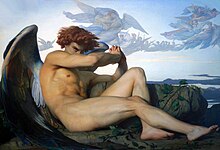
Like Roman Catholicism, Protestantism continues with the concept of fallen angels as spiritual entities unrelated to flesh, but it rejects the angelology and demonology established by the Roman Catholic Church. Martin Luther's (1483–1546) Sermons of the Angels merely recount the exploits of the fallen angels, and does not deal with an angelic hierarchy. Satan and his fallen angels are believed to be responsible for some misfortune in the world, but Luther always believed that the power of the good angels exceeds those of the fallen ones. The Italian Protestant theologian Girolamo Zanchi (1516–1590) offered further explanations for the reason behind the fall of the angels. According to Zanchi, the angels rebelled when the incarnation of Jesus Christ as the Son of God was revealed to them in incomplete form. While Mainline Protestants are much less concerned with the cause of angelic fall, arguing that it is neither useful nor necessary to know, other Protestant churches do have fallen angels as more of a focus.
Philosophy
In Western philosophy, the devil was understood as a personal identity of evil in opposition to good. Its conception as a fallen angel, in contrast to Manichaeistic absolute evil, allowed to avoid two separate ontological principles.
Theodicy, the question of how evil can exist simultaneously with the existence of an all-powerful and all-good God, may utilize the concept of fallen angels to explain natural evil. Accordingly, the angels would have great power, and by exercising havoc over the earth, they cause suffering and misery, manifesting in natural disasters. Accordingly, natural evil can be traced back to free-will (in that case of super-human agents). Opponents argue that this implies that fallen angels have supernatural powers to influence the world, powers left unproven, thus falling into a devil of the gaps.
Islam
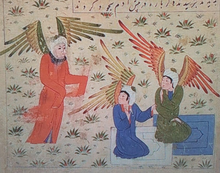
The concept of fallen angels is debated in Islam. Opposition to the possibility of erring angels can be attested as early as the influential Islamic ascetic Hasan of Basra (642–728). On the other hand, evidence for the belief in fallen angels among Muslims can be traced back to reports attributed to some of the companions of Muhammad, such as Ibn Abbas (619–687) and Abd Allah ibn Mas'ud (594–653). To support the doctrine of infallible angels, Hasan of Basra pointed at verses stressing out the piety of angels, while simultaneously reinterpreting verses which might imply acknowledgement of fallen angels. For that reason, he read the term mala'ikah (angels) in reference to Harut and Marut, two possible fallen angels mentioned in 2:102, as malikayn (kings) instead of malā'ikah (angels), depicting them as ordinary men and advocated the belief that Iblis was a jinn and had never been an angel before. However, none of these verses declare angels as immune from sin.
Contemporary Muslim scholars have argued, even if fallen angels are considered, they are conceptually different from the fallen angels in Christianity, since they remain at the service of God and do not become God's enemies. It has been stated that "(...) according to Christianity, the devils are fallen angels who renounced their loyalty to God, in Islam it is God who dismissed the fallen angels".
The Quran mentions the fall of Iblis in several Surahs. Surah al-Anbiya states that angels claiming divine honors were to be punished with hell. Further, Surah 2:102 implies that a pair of fallen angels introduces magic to humanity. According to the Isma'ilism work Umm al-Kitab, Azazil, the first angel created by God, boasts about himself being superior to God until he is thrown into lower celestial spheres and ends up on earth. Iblis is often described as being chained in the lowest pit of hell (Sijjin) and commands, according to Al-Tha'labi (961–1038), his host of rebel angels (shayāṭīn) and the fiercest jinn (ifrit) from there. In a Shia narrative from Ja'far al-Sadiq (700 or 702–765), Idris (Enoch) meets an angel, which the wrath of God falls upon, and his wings and hair are cut off; after Idris prays for him to God, his wings and hair are restored. In return they become friends and at his request the angel takes Idris to the heavens to meet the angel of death. In a similar story, a cherub called Fuṭrus (فطرس) was cast out from heaven and fell to the earth. When Muhammad intercedes for the angel and God restores his wings after he touches al-Husayn's cradle.
Some recent non-Islamic scholars suggest Uzair, who is according to Surah 9:30 called a son of God by Jews, originally referred to a fallen angel. While exegetes almost unanimously identified Uzair as Ezra, there is no historical evidence that the Jews called him son of God. Thus, the Quran may refer not to the earthly Ezra, but to the heavenly Ezra, identifying him with the heavenly Enoch, who in turn became identified with the angel Metatron (also called lesser YHWH) in Merkabah mysticism.
Iblis
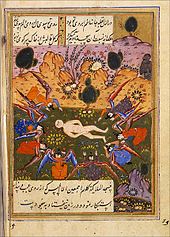
The Quran repeatedly tells about the fall of Iblis. According to Quran 2:30, the angels object to God's intention to create a human, because they will cause corruption and shed blood, echoing the account of 1 Enoch and the Book of Jubilees. This happens after the angels observe men causing unrighteousness. However, after God demonstrates the superiority of Adam's knowledge in comparison to the angels, He orders them to prostrate themselves. Only Iblis refuses to follow the instruction. When God asks for the reason behind Iblis' refusal, he boasts about himself being superior to Adam, because he is made of fire. Thereupon God expels him from heaven. In the early Meccan period, Iblis appears as a degraded angel. But since he is called a jinni in Surah 18:50, some scholars argue that Iblis is actually not an angel. This is the position of the tradition from Hasan al-Basri, who argued that Iblis is not an angel, but an entity apart, and the father of the jinn. Therefore, they reject the concept of fallen angels and emphasize the nobility of angels by quoting certain Quranic verses like 66:6 and 16:49, distinguishing between infallible angels and jinn capable of sin.
On the other hand, the tradition from Ibn Abbas allows the concept of fallen angels. According to Ibn Abbas, angels who guard the jinan (here: heavens) are called Jinni, just as humans who were from Mecca are called Mecci (nisba), but they are not related to the jinn-race. This tradition asserts that Iblis and his angels are made from "poisonous fire" (nār as-samūm), the rest of the angels from "light" (Nūr), and the jinn mentioned in the Quran were created from "a mixture of fire" (mārijin min nār). Other scholars assert that a jinn is everything hidden from human eye, both angels and other invisible creatures, thus including Iblis to a group of angels.
In Surah 15:36, God grants Iblis' request to prove the unworthiness of humans. Surah 38:82 also confirms that Iblis' intrigues to lead humans astray are permitted by God's power. However, as mentioned in Surah 17:65, Iblis' attempts to mislead God's servants are destined to fail. The Quranic episode of Iblis parallels another wicked angel in the earlier Books of Jubilees: Like Iblis, Mastema requests God's permission to tempt humanity, and both are limited in their power, that is, not able to deceive God's servants. However, the motif of Iblis' disobedience derives not from the Watcher mythology, but can be traced back to the Cave of Treasures, a work that probably holds the standard explanation in Proto-orthodox Christianity for the angelic fall of Satan. According to this explanation, Satan refuses to prostrate himself before Adam, because he is "fire and spirit" and thereupon Satan is banished from heaven. Unlike the majority opinion in later Christianity, the idea that Iblis tries to usurp the throne of God is alien to Islam and due to its strict monotheism unthinkable.
Harut and Marut
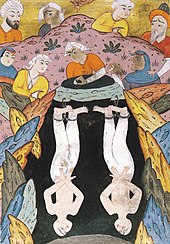
Harut and Marut are a pair of angels mentioned in Surah 2:102 teaching magic. Although the reason behind their stay on earth is not mentioned in the Quran, the following narration became canonized in Islamic tradition. The Quran exegete Tabari attributed this story to Ibn Masud and Ibn Abbas and is also attested by Ahmad ibn Hanbal. Briefly summarized, the angels complain about the mischievousness of mankind and make a request to destroy them. Consequently, God offers a test to determine whether or not the angels would do better than humans for long: the angels are endowed with human-like urges and Satan has power over them. The angels choose two (or in some accounts three) among themselves. However, on Earth, these angels entertain and act upon sexual desires and become guilty of idol worship, whereupon they even kill an innocent witness of their actions. For their deeds, they are not allowed to ascend to heaven again.
Probably the names Harut and Marut are of Zoroastrian origin and derived from two Amesha Spentas called Haurvatat and Ameretat. Although the Quran gave these fallen angels Iranian names, mufassirs recognized them as from the Book of Watchers. In accordance with 3 Enoch, al-Kalbi (737 AD – 819 AD) named three angels descending to earth, and he even gave them their Enochian names. He explained that one of them returned to heaven and the other two changed their names to Harut and Marut. However, like in the story of Iblis, the story of Harut and Marut does not contain any trace of angelic revolt. Rather, the stories about fallen angels are related to a rivalry between humans and angels. As the Quran affirms, Harut and Marut are sent by God and, unlike the Watchers, they only instruct humans to witchcraft by God's permission, just as Iblis can just tempt humans by God's permission.
Literature and popular culture

In the Divine Comedy (1308–1320) by Dante Alighieri, fallen angels guard the City of Dis surrounding the lower circles of hell. They mark a transition: While in previous circles, the sinners are condemned for sins they just could not resist, later on, the circles of hell are filled with sinners who deliberately rebel against God, such as fallen angels or Christian heretics.
In John Milton's 17th-century epic poem Paradise Lost, both obedient and fallen angels play an important role. They appear as rational individuals: their personality is similar to that of humans. The fallen angels are named after entities from both Christian and Pagan mythology, such as Moloch, Chemosh, Dagon, Belial, Beelzebub and Satan himself. Following the canonical Christian narrative, Satan convinces other angels to live free from the laws of God, thereupon they are cast out of heaven. The epic poem starts with the fallen angels in hell. The first portrayal of God in the book is given by fallen angels, who describe him as a questionable tyrant and blame him for their fall. Outcast from heaven, the fallen angels establish their own kingdom in the depths of hell, with a capital called Pandæmonium. Unlike most earlier Christian representations of hell, it is not the primary place for God to torture the sinners, but the fallen angels' own kingdom. The fallen angels even build a palace, play music and freely debate. Nevertheless, without divine guidance, the fallen angels themselves turn hell into a place of suffering.
The idea of fallen angels plays a significant role in the various poems of Alfred de Vigny. In Le Déluge (1823), the son of an angel and a mortal woman learns from the stars about the great deluge. He seeks refuge with his beloved on Mount Ararat, hoping that his angelic father will save them. But since he does not appear, they are caught by the flood. Éloa (1824) is about a female angel created by the tears of Jesus. She hears about a male angel, expelled from heaven, whereupon she seeks to comfort him, but goes to perdition as a consequence.
The Turkish horror film Semum (2008), produced and directed by Hasan Karacadağ, is about a shayṭān who has been summoned from hell to torment a woman named Canan. The movie is based on the Ibn Abbas interpretation of the Quran and depicts the devil as a fallen angel who seeks revenge on humans for being abandoned by God (Allah). The devil accepts ʿAzāzīl as his new deity, who is praised as the ruler of hell and supporting his minions against God's new creation (humans). However, at the end, the movie affirms in accordance with Islamic teachings, that ʿAzāzīl has no real power but only to seduce people to follow him. When the shayṭān battles a human priest (Hoca) in hell, it is God who intervenes on behalf of humanity while ʿAzāzīl has forsaken his servant. By that, the movie further rejects dualism in favor of Islamic tawḥīd, emphazising that even hell is under God's control.
